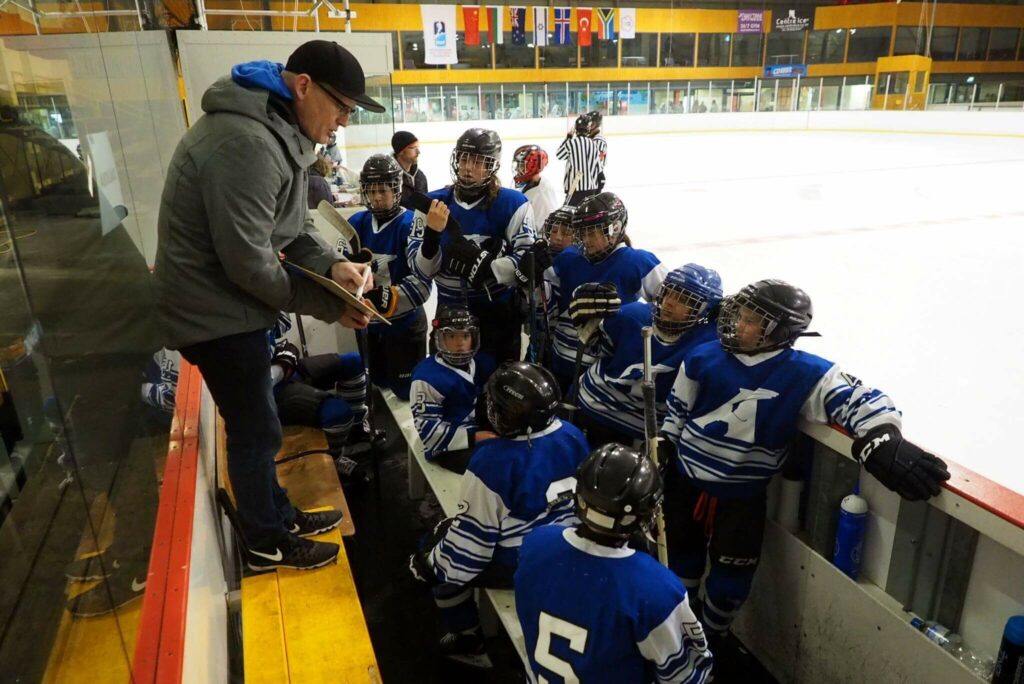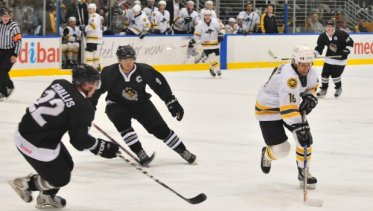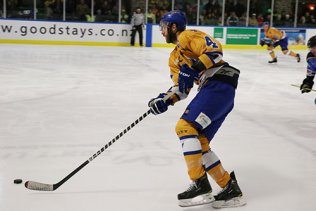
CENTRE ICE: PART 2 – MIDDLE OF THE ICE
PART 2: THE MIDDLE OF THE ICE
Last month, we explored the origins and beginnings of Centre Ice, as well as the Blong family and how they became synonymous with ice hockey in New Zealand. This month, we’re taking a look at Centre Ice as it operates today, and how Darren (its owner) is still heavily involved in the sport and helping the next band of Kiwi hockey players develop. This piece highlights how important Centre Ice is and has been to so many young kids coming through, as well as adults playing the game today.
It’s easy to look at Centre Ice and see it purely as a business. “Here’s a guy who sells hockey gear, in a sport that’s relatively expensive, to a niche market in New Zealand.”But you only have to have one conversation with Darren or take a passing look at the shop’s walls – littered with memorabilia – to see that hockey means more to the Blong’s than sales and margins.
Put plainly – hockey is a passion, not a business.
“Obviously we’re trying to make money, but the reality is you can’t retire on it,” Darren said. “From my perspective, I do it fundamentally because I just want kids to have a good experience in sport and stay in it – especially in hockey.” When Darren picked up hockey many years ago, he and a few mates had to find their own way of playing, learning, and developing. However, there were a large number of people who gave up on the sport because systems weren’t in place. Now, with the game taking a big turn in the past five years, New Zealand ice hockey is seeing a surge both in playing numbers and retention. “We’re only about three years deep into our plan, but in 2019 our Learn-to-Play up to under-18 numbers were up 8%,” Darren said. “Overall numbers for hockey in New Zealand were up 13%.”
Darren and Centre Ice have been a big part of that.
Of course, the business is able to supply kids and clubs with gear, but Darren sees it more as a conjugate for allowing him the space and time to help coach. “It pays my wages and that gives me the space to be able to do all the coaching I am doing. A third of my working week is doing volunteer stuff behind the scenes and I can’t do that without having Centre Ice operating in the background.” So while Centre Ice on the surface looks like a shop and an online store, its roots go much deeper, and as they say – business is about the people, not the products.
HELPING THE NEXT GENERATION OF HOCKEY PLAYERS
Darren grew up with a sprinkling of coaching experience. That, in part, came from the fact he was almost forced into it out of necessity. “I was invariably involved because we didn’t necessarily have anyone behind the bench at club level.” But it wasn’t until Darren had his daughters, Janna and Katya, that coaching started to become front and center. “Katya bugged me from a very early age to play hockey,” Darren said. “When she was about three or four, we put her into skate school and obviously I fell into coaching her as people do and that sort of started the journey.” Darren was encouraged by Andy Mills to head to Queenstown in 2012, where the Leslie Brothers from North America were coming over to do some training camps.
That opened up Darren’s eyes to a new way of doing things.
“It was all about keeping things simple, with lots of repetition, small area skill-based games, and a lot of fun,” he said. “That got me keen to do more and learn more and even though initially it was to support Katya, it moved me into wanting more kids in skates and having this done everywhere.” From that Darren became more involved with coaching and that eventually led to his role as National Coaching Director. There’s no mistaking his passion for hockey, and his catchphrase, “Keeping more kids in skates” is something that’s almost as recognisable as his name. His focus shifted solely from the business of Centre Ice, to asking how he can do more to help the game grow and become part of a hockey revolution.
WHERE HOCKEY IS AT NOW?
The way kids learn hockey in New Zealand has undergone a massive shift, and the results speak for themselves. There are now far more opportunities for kids to learn the game, and stay in it, as they progress through the Learn to Play programmes, into juniors etc. Coupled with a shift in how those programmes operate, player retention has remained high as well. “The way the world is now, we’re all on our phones and we’re distracted, and everyone loses interest very quickly,” Darren said. “Hockey is something that fundamentally is the completely opposite of that. It’s an accident, but it’s a good accident. “In saying that, we’re trying to cater our coaching to the kids in order to suit what they want and need. “The way we train now in small areas, that is the way the world is doing it. Quick eight-minute drills that you change in and out of, from juniors all the way up to national league.” All of this helps hockey become more appealing to youngsters, and also keeps parents involved as they’re constantly encouraged to learn and be involved whether that’s through coaching, refereeing, managing etc. The way hockey is played has also undergone some massive changes over the years – not just at the elite level, but in the way kids learn the game. A common misconception with hockey is that it’s overtly violent, and kids are at risk of serious injury.
But Darren, through his playing and coaching experience, is seeing a marked shift.
“There is a big misconception that the game is too violent or dangerous,” Darren said. “But you look even at the NHL level. They’ve clamped down on interference calls, shots to the head, aggressive board play, all because they want the game to be faster and more skillful. “The game has moved from hitting someone and getting out of the play, to being more about using your footwork to steer and angle and using your stick to be defensively sound. “From a New Zealand perspective, it’s all non-checking until they turn 18 anyway so the idea that kids are potentially getting laid out on the ice every game is a big misconception.”
The game is also becoming a lot more cost-friendly for youngsters. With growing numbers, clubs around the country are now able to be more efficient with ice time and coaches, meaning instead of 10 kids on the ice at one time, you’ve got 50. That helps to spread the cost of both the ice, and the coaches involved. All of these changes have helped create an environment for young hockey players that makes them and their parents want to stick with the sport. That in turn, will lead to more numbers at the junior level, and hopefully more players after high school, all of which will continue the upward trend of having more feet in skates.
It’s a simple model, but one that is essential for helping the game grow.
WHERE IS CENTRE ICE AT NOW?
Synonymous with the changes to hockey, have also been the changes to Centre Ice. Centre Ice has been in business for 25 years now. A lot has changed, and some things haven’t. What remains the same, is Darren’s commitment to operate in a competitive overseas market to help provide Kiwi hockey players with what they need. Centre Ice made the shift a few years ago to stop the wholesale side of their business. They now sell only directly to the consumer, and as the official Bauer distributor in New Zealand, there is no middleman. This means they can offer fair and competitive prices without having to clip the ticket each time. Combined with their Bauer air-service, Centre Ice can provide players with the latest Bauer equipment at a faster and often cheaper rate than online competitors overseas. “If you get the exchange rate calculator out, once you figure out the dollar conversion, shipping, taxes, all of that stuff, we’re pretty much bang on,” Darren said. “Where we can’t compete is the brands. We can’t carry ten brands in our shop because the market is so small here.”
But there is also a big plus with buying local.
“It’s a massive advantage for our customers because everything is under the Consumers Guarantee Act and buying online from somewhere else isn’t a problem until you have to put something right. “With us, when we have to put something right, you can talk to a human, that’s in the same time zone, and whether it’s shipping things back to the shop or taking photos, everything is a lot faster and lot less stressful. “If you buy online overseas, and something goes wrong, they’ll want you to ship it back to them at your own cost so then you’ve got that added factor. Nowadays, it’s also becoming more costly with fluctuating exchange rates as well as increased shipping times with COVID so there is a big incentive to buy local.” Darren knows that everyone has their preferences for brand and some people have their own channels for getting gear, but what Centre Ice aims to deliver is a service that fits the ethos of hockey in this country. And as the old cliché goes, when you buy from a small business, you’re not helping a CEO buy a third holiday home, you’re helping an owner put food on the table, kids through school, and petrol in the car. In Darren’s case, you’re also helping him coach and develop the next generation of hockey players in New Zealand.
CONCLUSION
To make hockey better for everyone, we need to include everyone. It doesn’t come down to a few people, it needs everyone taking an active role somewhere to help grow the game and keep people in the sport. Darren has been aiming to drive home that message ever since he realised Centre Ice could offer him much more than just business. There’s been a lot of change in the game over the past few years, and both Darren and Centre Ice have been an important part of that change. But the job is not done, not for Centre Ice or for New Zealand Ice Hockey. To find out what the future looks like, stay tuned for Part 3!
Written By Sam Hewat







